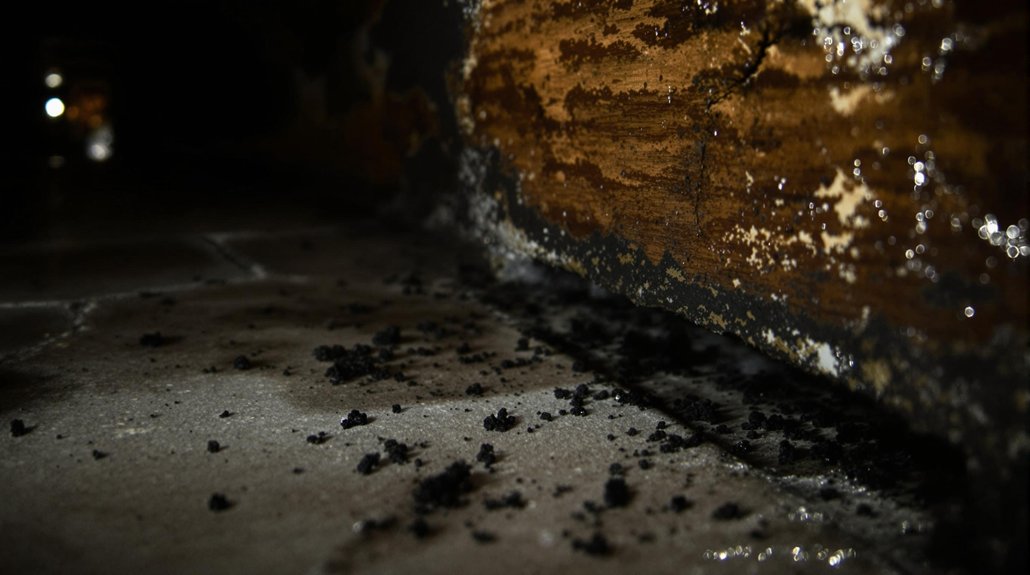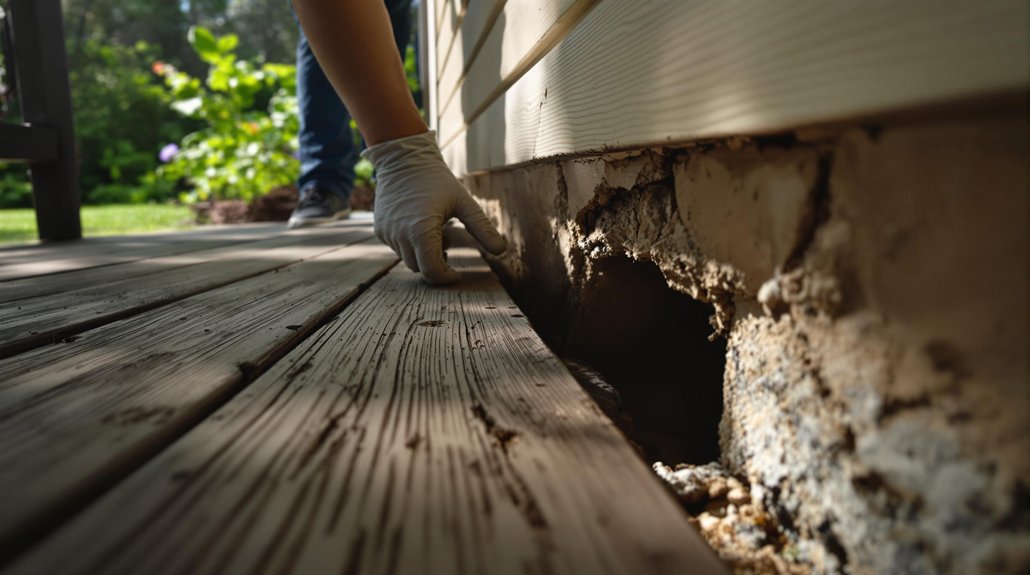Critter Wranglers, LLC Blog
Have an issue? Contact us today

How to Find Out Where Rats Are Getting In?
To find out where rats are getting in, start by inspecting your home thoroughly. Look for signs of infestation, like droppings or nesting materials. Check the exterior for cracks in the foundation or gaps around pipes. Pay attention to areas near doors and windows, ensuring they close tightly. Use materials like caulk or steel wool to seal any openings. Regular maintenance, such as trimming shrubs, can also help. If you notice activity at night, it might indicate entry points. By following these steps, you can better understand where rats may be entering, leading to more effective solutions.
Key Article Highlights
- Conduct a thorough exterior inspection to identify cracks, holes, and gaps around the foundation and walls of your home.
- Check utility openings where pipes enter the house, as these can be potential access points for rats.
- Look for signs of rat activity, such as droppings and gnaw marks, to determine where they may be entering.
- Inspect insulation around pipes for damage or gaps that could allow rats to gain entry into your home.
- Seal identified access points using materials like caulk, steel wool, or expanding foam to prevent future infestations.
Signs of Rat Infestation

When you suspect a rat problem, observing the signs of infestation is essential. One key indicator is droppings identification. Rat droppings are small, dark, and cylindrical, often found near food sources or nesting areas. Additionally, understanding rat behavior patterns can help you spot trouble. Rats are nocturnal, so you may notice signs of activity at night, such as scratching noises or gnaw marks on food containers. Look for burrows or nests, usually made of shredded materials, in hidden areas. These signs indicate that rats are present and may be seeking shelter. By recognizing these signs early, you can take appropriate action to address the issue and protect your environment from further infestation.
Inspecting Your Home's Exterior
A thorough inspection of your home's exterior is essential in identifying potential entry points for rats. Start by examining the foundation, walls, and roof for any cracks or holes that could allow pests to enter. Pay special attention to areas around vents, pipes, and wires. Regular home maintenance can help you spot these issues early. Trim back trees and shrubs to eliminate hiding spots for rats. Verify that doors and windows close tightly, as gaps can also serve as access points. Sealing these openings is a key step in pest prevention. By taking the time to inspect your home's exterior, you contribute to a safer environment for your family and prevent future infestations.
Checking for Entry Points

To find where rats might be entering your home, start by inspecting the exterior perimeter. Look closely for cracks in the foundation and any openings around utilities. Identifying these entry points is essential in preventing rodent access.
Inspect Exterior Perimeter
Inspecting the exterior perimeter of a building is essential in identifying potential entry points for rats. Start by checking for any gaps or holes in walls and around windows. Verify that exterior barriers are intact, as they can deter pests.
Here's a quick guide to help you:
| Area to Inspect | Landscaping Tips |
|---|---|
| Siding and Foundation | Trim shrubs away from walls |
| Doors and Windows | Seal openings with weather stripping |
| Drainage Areas | Clear debris to prevent nests |
Examine Foundation Cracks
After ensuring that the exterior perimeter is secure, the next step involves examining the foundation for cracks. Small openings in the foundation can be entry points for rats. Inspect the foundation closely to identify any damage requiring foundation repair.
- Look for visible cracks, especially larger ones.
- Check for gaps around pipes and vents.
- Inspect the area near the ground where the foundation meets the soil.
- Keep an eye on any signs of moisture or decay.
Addressing these issues is essential for effective pest prevention. Filling in cracks and repairing the foundation can help keep rats and other pests out of your home. Taking these proactive steps will contribute to a healthier living environment.
Check Utility Openings
While evaluating potential entry points for rats, it is crucial to check utility openings around your home. These openings provide utility access for pipes and wires, which can create easy pathways for rodents. Inspect areas where pipes enter your home, as gaps may exist. Look closely at the insulation around these pipes; if it is damaged or missing, it may allow rats to squeeze through. Seal any gaps with materials like steel wool or caulking to prevent entry. Additionally, verify that any vents are covered with mesh to block access. By addressing these utility openings, you can greatly reduce the risk of rat infestations and keep your home safe and secure.
Utilizing Traps and Bait
Traps and bait are essential tools for managing rat infestations. Understanding the different types of traps and effective bait strategies can help improve your efforts. By selecting the right methods, you can better identify and control rat activity in your space.
Types of Traps
Identifying the right type of trap is essential for effective rodent control. Different traps serve various needs and preferences. Here are some common types of traps:
- Snap traps: Quick and effective, these traps kill rodents instantly.
- Live traps: These capture rats without harming them, allowing for relocation.
- Glue traps: Sticky surfaces capture rodents, but may not be the most humane option.
- Electric traps: These deliver a lethal shock, ensuring a quick end to the problem.
Choosing the appropriate trap depends on your situation and values. Consider how you want to address the rodent issue, whether you prefer a lethal or humane approach. Each trap has its benefits and drawbacks, so weigh your options carefully before proceeding.
Effective Bait Strategies
Choosing the right trap is only part of the solution when it comes to controlling a rat problem. Effective bait strategies are essential for success. Begin by selecting the right bait types, such as peanut butter, dried fruit, or commercial rat bait. These options attract rats due to their strong scents and flavors.
Next, focus on bait placement. Position the bait near areas where you have noticed rat activity, like droppings or gnaw marks. Make sure that traps are placed along walls or in corners, as rats prefer to travel along these paths. Regularly check and replace bait as needed to maintain effectiveness. By combining proper bait types with strategic bait placement, you can enhance your efforts in managing rat invasions.
Monitoring Indoor Activity

Monitoring indoor activity is essential for detecting signs of rat infestations. By observing their behavior, you can understand their monitoring habits
Sealing Potential Access Areas
Sealing potential access areas is a crucial step in preventing rat infestations. Rats can enter through small openings, so it is essential to identify and secure these entry points. Start by inspecting the exterior of your home for cracks and gaps. Use effective sealing methods, such as caulk or expanding foam, to close these spaces. Additionally, install weather stripping around doors and windows to block any gaps that may allow entry. Pay special attention to areas near pipes and vents, as these are common access points. By taking these precautions, you can greatly reduce the chances of a rat infestation and create a safer environment for your home and community.
Frequently Asked Questions
What Are the Health Risks Associated With Rat Infestations?
Rat infestations pose significant health hazards, often underestimated. These rodents can facilitate disease transmission, including leptospirosis and hantavirus. Addressing infestations promptly is essential to protect public health and guarantee safer environments for communities.
How Do Weather Conditions Affect Rat Entry Points?
Weather patterns and temperature fluctuations markedly influence rat behavior and entry points. Extreme conditions may drive rats indoors, while milder weather can lead them to explore new areas, increasing the likelihood of infestations in human structures.
Are There Specific Times of Year When Rats Are More Active?
Rats exhibit increased activity during specific times of the year, particularly aligned with their breeding cycles. Seasonal patterns, such as warmer weather, often result in heightened foraging and nesting behaviors, consequently increasing their presence in urban areas.
Can Pets Help Detect Rat Infestations?
Like a silent detective, pets can exhibit unusual behavior that signals rat infestations. Their heightened senses can assist in detection methods, making them valuable allies in identifying and addressing pest-related issues within the home.
What Materials Are Most Effective for Sealing Entry Points?
Effective materials for sealing entry points include caulking materials and steel wool. Caulking provides a smooth seal, while steel wool effectively blocks gaps, preventing rats from entering. Using both can enhance the protection of your space.
